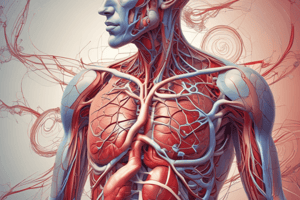Podcast
Questions and Answers
Which of the following factors affects resistance to blood flow?
Which of the following factors affects resistance to blood flow?
- Arterial pressure
- Cardiac output
- Total peripheral resistance (correct)
- All of the above
What is the equation for arterial pressure according to Guyton?
What is the equation for arterial pressure according to Guyton?
- Arterial pressure = cardiac output + total peripheral resistance
- Arterial pressure = total peripheral resistance / cardiac output
- Arterial pressure = cardiac output x total peripheral resistance (correct)
- Arterial pressure = cardiac output / total peripheral resistance
What is the equation for Reynolds number (Re)?
What is the equation for Reynolds number (Re)?
- Re = (velocity of flow) / (radius of vessel) x viscosity
- Re = (velocity of flow) + (radius of vessel) x viscosity
- Re = (velocity of flow) x (radius of vessel) / viscosity (correct)
- Re = (velocity of flow) / (radius of vessel) / viscosity
What does Reynolds number (Re) indicate about fluid flow?
What does Reynolds number (Re) indicate about fluid flow?
Which of the following is likely to increase Reynolds number (Re) and result in turbulent flow?
Which of the following is likely to increase Reynolds number (Re) and result in turbulent flow?
What is the effect of flow on viscosity?
What is the effect of flow on viscosity?
What is the equation for Reynolds number (Re) according to the text?
What is the equation for Reynolds number (Re) according to the text?
According to LaPlace's Law, the tension (T) in the vessel wall is proportional to the distending pressure (P) and the radius (R) of the vessel. Which of the following equations represents this relationship correctly?
According to LaPlace's Law, the tension (T) in the vessel wall is proportional to the distending pressure (P) and the radius (R) of the vessel. Which of the following equations represents this relationship correctly?
Which of the following is NOT a practical consequence of LaPlace's Law?
Which of the following is NOT a practical consequence of LaPlace's Law?
Which of the following is NOT a site of tissue blood flow regulation?
Which of the following is NOT a site of tissue blood flow regulation?
Which of the following is NOT a mechanism of regulation of tissue blood flow?
Which of the following is NOT a mechanism of regulation of tissue blood flow?
Which of the following is NOT an example of acute regulation of local blood flow?
Which of the following is NOT an example of acute regulation of local blood flow?
Which of the following is NOT a basic principle of circulatory function?
Which of the following is NOT a basic principle of circulatory function?
Which of the following is a specialized flow mentioned in the text?
Which of the following is a specialized flow mentioned in the text?
Which of the following is NOT a learning outcome mentioned in the text?
Which of the following is NOT a learning outcome mentioned in the text?
Which of the following is a learning outcome mentioned in the text?
Which of the following is a learning outcome mentioned in the text?
What is the effect of flow on viscosity?
What is the effect of flow on viscosity?
Which of the following is NOT a mechanism of regulation of tissue blood flow?
Which of the following is NOT a mechanism of regulation of tissue blood flow?
What is the equation for arterial pressure according to the text?
What is the equation for arterial pressure according to the text?
What does Reynolds number (Re) indicate about fluid flow?
What does Reynolds number (Re) indicate about fluid flow?
Which of the following is NOT a basic principle of circulatory function?
Which of the following is NOT a basic principle of circulatory function?
What is the equation for Reynolds number (Re) according to the text?
What is the equation for Reynolds number (Re) according to the text?
Which of the following is the correct order of the phases of a cardiac action potential?
Which of the following is the correct order of the phases of a cardiac action potential?
Which of the following is responsible for the rapid depolarization in Phase 0 of a cardiac action potential?
Which of the following is responsible for the rapid depolarization in Phase 0 of a cardiac action potential?
Which of the following is responsible for the start of repolarization in Phase 1 of a cardiac action potential?
Which of the following is responsible for the start of repolarization in Phase 1 of a cardiac action potential?
Which of the following is responsible for the effect of Ca2+ entry in Phase 2 of a cardiac action potential?
Which of the following is responsible for the effect of Ca2+ entry in Phase 2 of a cardiac action potential?
Which of the following is responsible for the rapid repolarization in Phase 3 of a cardiac action potential?
Which of the following is responsible for the rapid repolarization in Phase 3 of a cardiac action potential?
Which of the following is responsible for the stable resting membrane potential in Phase 4 of a cardiac action potential?
Which of the following is responsible for the stable resting membrane potential in Phase 4 of a cardiac action potential?
Which of the following is responsible for the positive chronotropic effect of sympathetic stimulation on pacemaker activity?
Which of the following is responsible for the positive chronotropic effect of sympathetic stimulation on pacemaker activity?
Which of the following is responsible for the negative chronotropic effect of parasympathetic stimulation on pacemaker activity?
Which of the following is responsible for the negative chronotropic effect of parasympathetic stimulation on pacemaker activity?




